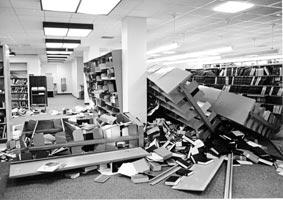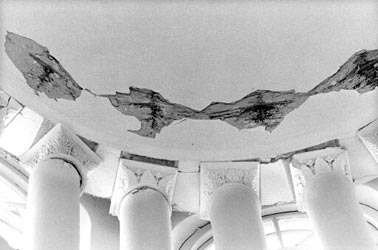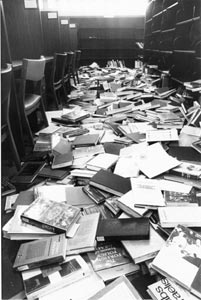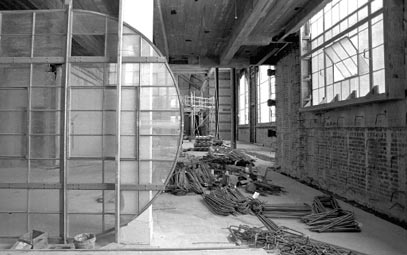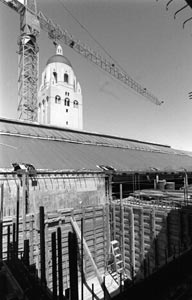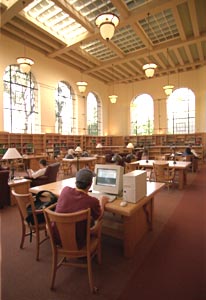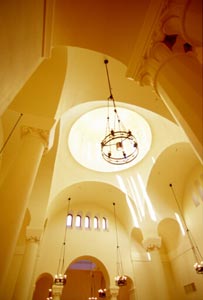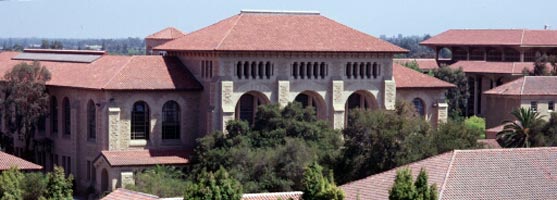|
|
||||||||||
 |
|
|
|
|||||||
|
|
||||||||||
|
|
|
|
|
|
|
|
|
|||
|
|
|
|
|
|
|
|
|
|
|
|
Walking Tour
| << Previous Stop |
 |
||||||||||||
|
“Earthquakes are written into this building. It replaced a destroyed library. The architects of the 1919 structure were those who designed City Hall in San Francisco—a work whose rapid rise in the midst of the 1906 ruins was meant to symbolize the City’s resurrection from its own ashes. And now, the entirely restored Bing Wing symbolizes for us the final phase of Stanford’s own brilliant recovery from its state on October 17, 1989.” — John Bender, Bing Wing Rededication Speech, 1999. Total Losses, 1906 After the 1906 earthquake, damage initially appeared to be considerably more expensive than careful examination later revealed. The University was comprised of 42 buildings and arcades at the time, and President Jordan’s first hasty figure estimated the financial loss to be as high as $2.8 million ($57.5 million adjusted to 2005). In a signed message issued by the Associated Press the day after the quake, Jordan had boosted the estimate to $4 million. These figures were exaggerated, but the loss was nonetheless considerable. Under the direction of the Commission of Engineers, the total cost of restoring all the buildings, not including Memorial Church, exceeded $650,000. Because Memorial Church was dismantled and almost entirely rebuilt, it alone amassed nearly as large a bill. Just 15 years earlier, the entire Inner Quadrangle had been constructed for $537,000. The Gymnasium and Library were not restored, but the ultimate cost of replacing the lost space and functionality amounted to approximately $750,000. The wrecked additions to the Museum were never replaced. Stanford’s “Self-Insurance” Policy In June of 1985, Stanford’s earthquake insurance policy was cancelled since its insurer was wary of the risk of the California market. Stanford’s office of Risk Management searched for another insurer but was quoted exorbitantly high premiums. Insurance was also recognized to be a somewhat unreliable investment due to the size of the institution and the possibility that insurers could not actually afford to reconstruct the University in the wake of a serious disaster. The State Insurance Commissioner investigated the matter and determined that earthquake insurance for Stanford was not reasonably priced or adequate in coverage. The Federal Emergency Management Agency (FEMA) was informed of this finding, and Stanford proceeded with a policy of “self-insurance” against earthquakes. “Self-insurance” motivates the seismic upgrade of older and high-value buildings to current codes in order to minimize the risk of damage in future earthquakes. To the extent that seismic retrofits and upgrades were executed by 1989, they were highly successful and conceivably saved hundreds of lives. The History Corner, Old Pavilion (Ford Center), and Roble Hall, for example, had been retrofitted in the 1980s, and suffered minimal damage in 1989. Roble had reopened just three weeks before Loma Prieta and would likely have collapsed without its new bracing. Director of Risk Management Jeffrey Seilbach reported that none of the buildings that were up to code were damaged. Unfortunately, Stanford had reserved a fund of only $7 million for emergency repairs when the Loma Prieta earthquake took place on October 17, 1989. The 15-second quake damaged 242 Stanford buildings, 20 of which were closed. Stanford faced an expensive repair program and decided to turn to FEMA for help. FEMA’s Role in Rebuilding Stanford after 1989 The Federal Emergency Management Agency (FEMA) was established by President Jimmy Carter in 1979 to “reduce loss of life and property and protect the nation’s critical infrastructure from all types of hazards through a comprehensive, risk-based, emergency management program of mitigation, preparedness, response and recovery.” FEMA becomes involved in a disaster when a Preliminary Damage Assessment (PDA) indicates that the destruction exceeds the state’s ability to respond. In such an event, a federal disaster is declared. This declaration guarantees that a portion of the recovery costs will be assumed by the federal government. When Loma Prieta was designated as such, FEMA was required by law to provide 75 percent of the funds necessary to repair damaged structures. Because FEMA had been notified of Stanford’s earthquake insurance situation, Stanford was eligible to apply for FEMA funding to decrease the burden of repairing its academic buildings. Although the percentage of aid was fixed, the challenge was to agree on the extent of the damage and the appropriate repair. Jean Barnes, Associate Director of Land and Buildings, described the FEMA negotiations as the phenomenon of the “incredible shrinking DSR.” A DSR, or Damage Survey Report, details the damage a building has incurred as well as the cost of its repair. Engineers will approach repairs differently, but in Stanford’s case after Loma Prieta, disagreements about the amount of damage that existed prior to the quake, the appropriate repair scheme, and how much the government was required by law to pay caused DSRs for buildings that started at $1 million to fall as low as $10,000. FEMA said that it should only support the cost of repairing buildings to their pre-quake condition. In the case of Stanford’s many unreinforced masonry buildings, that would amount to minmal epoxy grouting of cracks. Figure 4: In the wake of the Loma Prieta earthquake, what was then known as Green Library West was not only repaired but also restored and improved The University launched an appeal for 10 critical underfunded buildings. Santa Clara County had declared the buildings to be unsafe for human occupancy as a result of the earthquake and would not permit Stanford to reopen them until structural repairs took place in accordance with the County’s Unreinforced Masonry (URM) Ordinance. The URM Ordinance was a less stringent building code than the Uniform Building Code, which would apply to building repairs and upgrade in the absence of the URM Ordinance, Stanford argued. The repairs Stanford was asking FEMA to fund were the minimum necessary to comply with the URM code and reopen the buildings. Finally, Stanford asserted, the repair designs proposed by FEMA to the County did not comply with the minimum structural and life-safety standards required by the URM Ordinance, did not meet generally accepted earthquake engineering standards, and had already been rejected by County authorities as inappropriate for damaged unreinforced masonry buildings. Federal law and regulations required FEMA to fund repairs to bring buildings back to their pre-disaster designs and in conformance with applicable building codes. According to Chief Financial Officer Peter Van Etten, the “attitude at FEMA changed significantly with the arrival of new director James Witt,” a Clinton administration appointee who drew nationwide praise for greatly improving the responsiveness of FEMA to disasters. Key to the settlement was FEMA’s new position on seismic hazard mitigation upgrades. FEMA ultimately assessed the damage to Stanford at $67 million, $50.3 million of which it underwrote. The State of California’s disaster assistance program also contributed $5 million. The buildings that qualified for FEMA money, however, did not make up the only damage on campus. Memorial Church, for example, was nonacademic and therefore did not qualify, the Old Chemistry Building had been vacated prior to the quake, and many buildings sustained structural or cosmetic damage but had not been closed. The total repair bill was approximately $160 million, an amount equal to 7 percent of the total replacement cost of all campus assets. The University solicited alumni donations—many through 1994’s Stanford Restoration Fund—to supplement the FEMA contribution and ultimately spent $300 million to repair damaged structures, seismically strengthen over a hundred other buildings, and restore some of its most cherished historical buildings. Green Library West: Stanford’s Largest FEMA Claim Green Library West, known as the Main Library from its construction in 1917 until it was connected to its replacement in 1979, suffered severe damage during the quake and, followed by the Stanford Museum and the Geology and Language Corners, was the largest FEMA claim on the Stanford campus. Thousands of volumes had plunged to the floor, decorative columns were shifted, and cracks as long as 30 feet appeared (Figures 1-3). “When we walked up to my office, we could see daylight coming through cracks in the corners,” University Archivist Maggie Kimball said. The 700,000 books in Green Library West’s collection fared much better than they would have had a $5.5 million seismic bracing effort of the seven stories of stacks not taken place in 1988. After assessing the damage and considering many factors, not the least of which was the great amount of damage caused throughout the campus, the University administration wisely made the decision to rebuild rather than demolish Green Library West. It took 12 DSRs to settle on the figure of $21 million to repair and retrofit the facility. In addition to the $15.8 million that made up its share of the repair costs, FEMA devoted $2.7 million toward a new auxiliary library facility (SAL 3), relocating staff and books, and other miscellaneous costs. The overall restoration project, which integrated other upgrades and programmatic improvements, cost a total of $56 million (Figures 4, 5). After Loma Prieta, the building was immediately closed, its rooms and stacks emptied and relocated to an auxiliary building, and its staff disbursed to several temporary locations. The result of a ten-year effort was the rebirth of a magnificent library that is structurally sound, programmatically state-of-the-art, and architecturally and historically sympathetic to the original design (Figures 6-8). In the words of the University Librarian Michael Keller, “[…] in this restoration of the Main Library, now to be known as the Bing Wing, we have attempted to be true to the simple grandeur of the building, while accommodating the incredible changes in the University and its libraries in the years since 1916. We have tried as well to prepare for the unforeseeable possibilities of the future.” See an image gallery of the Library
|
|||||||||||
| << Previous Stop |
